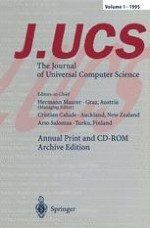J.UCS is the electronic journal that covers all areas of computer science. The high quality of all accepted papers is ensured by a strict review process and an international editorial board of distinguished computer scientists. The online journal J.UCS is a prototype for modern electronic publishing. Distributed via the Internet, it supports all the search and navigation tools of advanced online systems. This first annual print and CD-ROM archive edition contains all articles published online in J.UCS during 1995. It allows easy and durable access without logging onto the Internet. Uniform citation of papers is guaranteed by identical page numbering and layout of all versions.
J.UCS is based on HyperWave (formerly Hyper-G), a networked hypermedia information system compatible with other systems.
